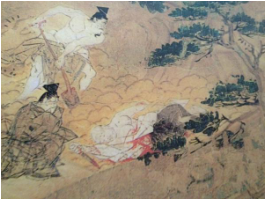 Source: togetter.com
Source: togetter.com And so, in such a cruel society, what could people do who didn`t have close connections to the law courts to enable them to win cases, or who did not possess the strength to be able to defend their cause, if they had to clash with an enemy? For them, a means did exist that would allow them to have justice without having to cry themselves to sleep, the most extreme form of revenge that existed in medieval Japanese society. (p.43)
Article 43 of the provincial laws (known as the Jinkaishū, or 塵芥集) set down by Date Tanemune of Mutsu (the great-grandfather of the `one-eyed dragon` Date Masamune) in the 5th year of Tenbun (1536) featured the following regulation;
“一、自害の事、題目を申し置き死に候はゞ、遺言の敵、成敗を加ふべきなり” (Item, in relation to acts of suicide, should the reason for the act be written down and left for posterity, the perpetrator shall be summarily punished)
In other words, if the person who committed suicide left a note detailing the `daimoku, 題目` or reason why they had committed suicide, the `perpetrator` (literally, the `enemy` described in the note) would later be punished by the Date family on behalf of the aggrieved (and deceased) plaintiff. To put it another way, in the lands controlled by the Date family during the Sengoku period, if one did not have the strength or influence to rid oneself of an enemy, if this same person later wrote down their grievances and committed suicide, the Date family would take it upon themselves to meet out justice on behalf of the deceased. Of course, although one could speak of `suicide`, there were many ways in which people might choose to off themselves, and so the Jinkaishū continued by saying that if the person concerned left no record of why they had done what they did, then the Date family would have nothing to do with them or their grievances. There was also a subclause added that noted that in some cases it would be necessary to judge such wills `on their merits` (or Jigi, 時宜). (p.44)
Yet just by going by the main text, it is obvious that in principle, the Date family gave particular respect to the will and testament of people who committed suicide, and so one can conclude that the Date acted as a sort of substitute or `stand in` to meet out revenge on behalf of the deceased and in accordance with public law.
To we in the modern age such a proviso seems contrary to all common sense, hence we must ask why the Date paid such close attention to the needs of suicide victims? To understand this, we must backtrack a bit to the Muromachi period. (p.44)
In the sixth month of the 1st year of Kakitsu (1441), Ashikaga Yoshinori, the shōgun, was assassinated by the Shugo Daimyō Akamatsu Mitsusuke at Mitsusuke`s residence in Kyoto. This was the so-called `Kakitsu Incident`. The Shugo Daimyō Ōuchi Mochiyo, out of sheer bad luck, happened to be in the same residence when the assassination was carried out, and so got caught up in the ensuing chaos and received life-threatening wounds. Nevertheless, Ōuchi did manage to make it back to his own residence. In the political chaos that engulfed Kyoto following such an unnatural death of the shōgun, a number of protests broke out as people learned of the `testament` of Ōuchi who lay at death`s door. According to this testament, Ōuchi said “As my wounds grow worse, should I die, those of my retainers that are left must hurry to the residence of the Kanrei and there commit seppuku”. (p.44)
By this time, a rumour had been going around Kyoto that this act of treachery had been organised by the Kanrei, Hosokawa Mochiyuki in league with Mitsusuke. Although it was later proven that Ōuchi`s testament was in fact a fake, the fact that the people of Kyoto at the time were prepared to believe that Ōuchi`s retainers had rushed into the Kanrei`s residence in order to commit ritual suicide so as to express the indignation of their lord has considerable value. As the Jinkaishū demonstrated, in the Muromachi period, to commit suicide was a means of expressing one`s anger and indignation at one`s enemy. For example, in the 1st month of the 4th year of Kakitsu (1444), a person by the name of Kitagawa Bō, who was apparently a retainer to the aristocrat Ōgimachi Sanjō family, committed seppuku out the front of the family library. At the time, some believed that Kitagawa had `gone awry`, while others believed that Kitagawa had acted as he did out of some anger or dissatisfaction towards his lord.(p.45)
We of course will never know the real reason why Kitagawa did what he did, yet this does provide an interesting example of what the people of the Muromachi period thought about the act of suicide. If Kitagawa was indeed of sound mind when he chose to commit suicide out the front of his lord`s treasured library, then we must first imagine that this was an expression of anger or dissatisfaction in his lord. In the Muromachi period, an act of suicide was clearly regarded as a powerful form of expression of rebuke or dissatisfaction towards one`s enemy. As the Jinkaishū also demonstrated, the passionate mentality of the people of the medieval period can be seen in the background of those acts labelled as suicide.(p.45)
 RSS Feed
RSS Feed